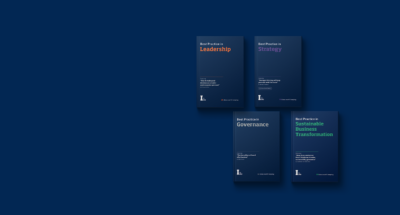
Building Better: How Baufritz is shaping the future of construction, one home at a time
Fritz-Kramer, the fourth-generation CEO of the 125-year-old family firm, is on a mission to change how Europe builds and lives more sustainably. ...

by Jad Mouawad, José Parra Moyano Published November 5, 2025 in Sustainability • 9 min read • 
Artificial intelligence has been looming over the energy debate, and its shadow keeps growing. Each week brings news of new mega data centers, each one larger and more power-hungry than the last, as companies race to develop faster and more powerful AI tools. Meta, the owner of Facebook and Instagram, has announced plans for multi-gigawatt “superintelligence” centers in Ohio and Louisiana, each nearly the size of Manhattan. This year alone, the six largest technology companies are investing over $300bn in data centers, fueling an arms race for computing power that’s driving up global electricity demand.
The International Energy Agency (IEA) estimates demand for these centers will account for 10% of the growth in global electricity needs for the next five years; in advanced economies, that share should reach 20%, representing a wake-up call to invest in more grids and generation capacity, according to the global energy advisor. The spectacular rise in AI demand and its impact on energy production, especially clean tech, is sparking tension between two of the most transformative forces shaping the 21st century. Will AI become a catalyst for the net-zero transition – or a drag on it?
The numbers are stark. Generative AI models consume up to 33 times more energy than traditional software. A typical AI-focused data center uses as much electricity as 100,000 homes. The next generation will consume 20 times more, equivalent to powering a city the size of Chicago.
Gartner predicts that by 2026, 80% of digital products will integrate AI features. The digital firm Area 17 sums up the view in its report on technology: “AI is no longer a future innovation or a backend technology; it’s on track to become the primary interface between businesses and their customers.”
This isn’t limited to digital. AI applications are spurring a new information revolution that will permeate every economic sector and industry with few equivalents in recent history. And this revolution, driving innovation deep into our economic systems, will run on computing power.
The source of this power will determine whether AI becomes a brown or a green technology. Data centers will account for nearly half of all power demand growth in the US between now and 2030. By then, the US is set to consume more electricity for data centers than for the production of aluminum, steel, cement, chemicals, and all other energy-intensive goods combined. Globally, data centers consumed 415 terawatt-hours (TWh) of electricity in 2024, about 1.5% of global demand. By 2030, this figure could more than double to 945 TWh, more than Japan’s entire power consumption.
So far, new AI loads are being met by a mix of renewables and natural gas. The IEA expects renewables to meet half of the growth in data center demand through 2035, with renewables generation projected to grow by over 450 TWh. But in markets such as the US, this investment frenzy is straining electricity grids, which are struggling to keep pace. Dominion Energy in Virginia has warned that new data center loads are forcing it to delay coal retirements, and Texas grid operator ERCOT has flagged AI and crypto mining as sources of instability.
Renewables alone won’t be enough. Fossil energy, such as natural gas, will play a crucial role, as well as other sources of dispatchable power, while the tech sector is helping to bring forward new nuclear and geothermal technologies. Natural gas is set to expand by 175 TWh to meet growing data center demand, and nuclear is expected to contribute about the same amount in additional generation, notably in China, Japan, and the US.
Despite this, these investments may fall short of demand: about 20% of data centers planned by 2030 are at risk of delays because of energy shortfalls, according to the IEA. This dash for new power sources comes at a cost for global emissions. According to a recent IMF article, the AI-driven rise in electricity demand could add 1.7 gigatons in global greenhouse gas emissions between 2025 and 2030, about as much as Italy’s energy-related emissions over a five-year period.

“The surging energy appetite of AI – especially for training large models – has led tech giants to invest heavily in small modular nuclear reactors to power data centers sustainably.”
Advocates argue that AI’s carbon footprint is only half the story and that its benefits may outweigh its costs. A recent study in Nature (co-authored by Nicholas Stern and Systemiq) found that AI could play a powerful role in supporting climate action while boosting sustainable and inclusive economic growth worldwide. It is estimated that AI could cut 3.2 to 5.4 gigatons of emissions annually by 2035, outweighing the increases in emissions from the power consumption of data centers. “The world faces an unprecedented opportunity to leverage AI as a catalyst for the net-zero transition,” the report says. Here are some examples:
In its immediate applications, AI is transforming energy grid management by enabling adaptive, self-learning networks that enhance efficiency and resilience. It now underpins electricity generation forecasts, real-time price optimization, and district heating management, allowing grids to move from reactive to adaptive self-learning networks that dynamically respond to changing supply and demand.
For example, the Baltic region uses AI to optimize transmission capacity, monitor systems remotely, and manage electric vehicle charging, supporting a shift to renewables and energy security in a highly digitalized energy system.
The surging energy appetite of AI – especially for training large models – has led tech giants to invest heavily in small modular nuclear reactors to power data centers sustainably. Quantum computing, with its lower energy consumption for complex computations, is emerging as a promising avenue to support AI innovation with reduced environmental impact.
However, uncertainties remain. For example, can nuclear power scale quickly enough and gain social acceptance to meet the energy needs of AI infrastructure? And how soon will quantum computing be viable at scale to alleviate AI’s energy footprint?
While AI brings powerful opportunities for energy efficiency and system optimization, its rapidly growing energy consumption urgently demands new approaches to decarbonization, infrastructure investment, governance, and cybersecurity in the energy sector. Policy intervention will likely be needed to help guide this transformation and mitigate risks. Governments will have a critical role to play, as market forces alone won’t be enough to drive the scale of the transformation needed.

The AI/energy story is not only about technology, energy, or grids. At its core, it’s a leadership challenge. The surge in computing demand is colliding with corporate net-zero ambitions, and executives can no longer treat energy use as a distant externality of digital growth. AI will either accelerate the net-zero transition or delay it, and business leaders will determine which way the balance tips.
To navigate this dilemma, organizations will need to break new ground. Here are four steps to consider:
These organizational shifts will not be easy. They will require boards to reconcile AI investments with climate commitments, push for more transparency, and consider trade-offs between growth and resilience. The leaders who succeed will be those who see the AI boom not just as a race for computing power, but as a test of whether innovation and sustainability can advance together.
Business leaders will determine whether AI accelerates or undermines the net-zero transition. Where do you stand on the following?
As you reflect on your AI strategy, stress-test your plans with these questions:

Communications consultant and former journalist
Jad Mouawad is a communications consultant and former journalist with over two decades of experience in energy and climate communications. He was a longtime business reporter for The New York Times and head of communications at the International Energy Agency. He currently works with international organizations, private-sector companies, think thanks and philanthropies on strategic communications. He holds a Bachelor’s degree from Brown University and a Master’s from Sciences-Po Paris, where he currently lives.

Professor of Digital Strategy
José Parra Moyano is Professor of Digital Strategy. He focuses on the management and economics of data and privacy and how firms can create sustainable value in the digital economy. An award-winning teacher, he also founded his own successful startup, was appointed to the World Economic Forum’s Global Shapers Community of young people driving change, and was named on the Forbes ‘30 under 30’ list of outstanding young entrepreneurs in Switzerland. At IMD, he teaches in a variety of programs, such as the MBA and Strategic Finance programs, on the topic of AI, strategy, and Innovation.

December 12, 2025 • by Julia Binder, Manuel Braun in Sustainability
Fritz-Kramer, the fourth-generation CEO of the 125-year-old family firm, is on a mission to change how Europe builds and lives more sustainably. ...

December 2, 2025 in Sustainability
Four books bring together the best I by IMD articles on leadership, strategy, governance, and sustainable business transformation. ...

December 1, 2025 • by Julia Binder, Knut Haanaes in Sustainability
In the second episode of IMD’s sustainability series, IMD's Julia Binder and Knut Haanaes welcome Kunal Chandra of RWE to discuss the energy transition....

November 27, 2025 • by Amanda Williams in Sustainability
Companies have buckled under pressure from the Trump administration and challenging economic conditions, but now's not the time to abandon sustainability goals....
 Audio available
Audio availableExplore first person business intelligence from top minds curated for a global executive audience